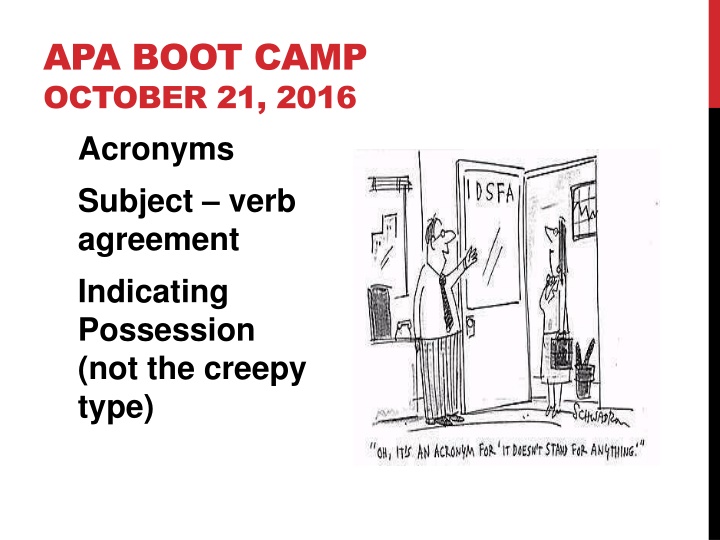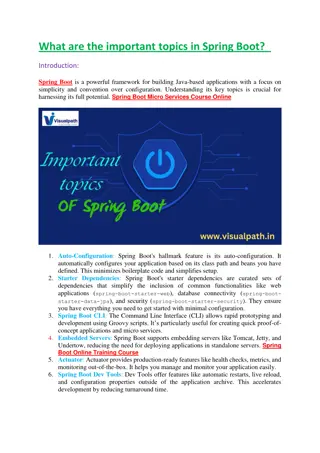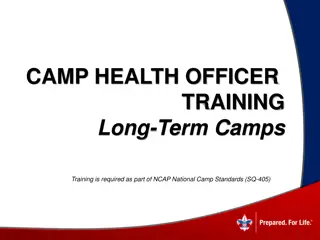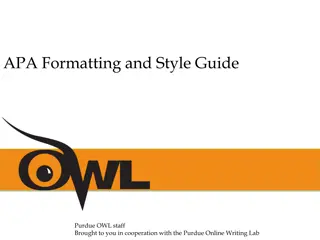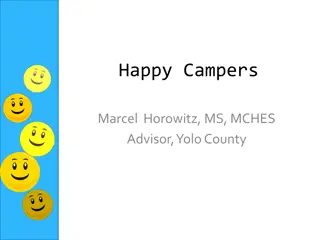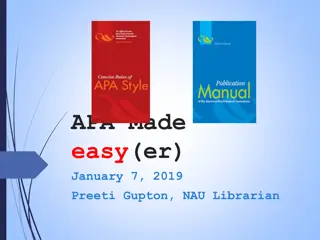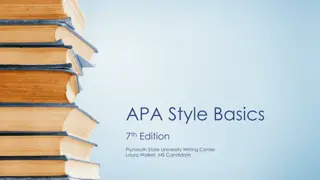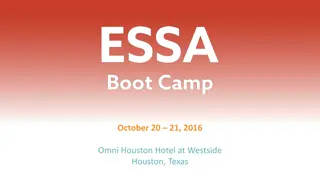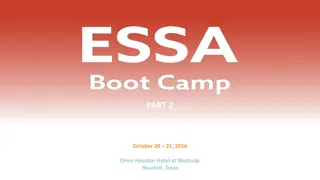APA Boot Camp - Acronyms & Subject Verb Agreement
Explore the rules for using acronyms and ensuring subject-verb agreement in APA style. Learn how to indicate possession appropriately without creating ambiguity. Understand the importance of clear writing and proper abbreviation usage to enhance communication in academic writing.
Uploaded on Feb 27, 2025 | 0 Views
Download Presentation

Please find below an Image/Link to download the presentation.
The content on the website is provided AS IS for your information and personal use only. It may not be sold, licensed, or shared on other websites without obtaining consent from the author.If you encounter any issues during the download, it is possible that the publisher has removed the file from their server.
You are allowed to download the files provided on this website for personal or commercial use, subject to the condition that they are used lawfully. All files are the property of their respective owners.
The content on the website is provided AS IS for your information and personal use only. It may not be sold, licensed, or shared on other websites without obtaining consent from the author.
E N D
Presentation Transcript
APA BOOT CAMP OCTOBER 21, 2016 Acronyms Subject verb agreement Indicating Possession (not the creepy type)
PRE-ASSESSMENT Work through the sheet by yourself, quickly. Just go with your first inclination.
ACRONYMS Don t overuse abbreviations; consider writing clarity. If you use a term less than 3 times in a paper, consider writing it out each time (p. 107) use only those abbreviations that will help you communicate with your reader (APA Manual, 2010, p. 107) Because the abbreviations that psychologists [and other professionals] use in their daily writing may not be familiar to students or to readers in other disciplines or other countries, a term to be abbreviated must, on its first appearance, be written out completely and followed immediately by its abbreviation in parentheses. Thereafter, use the abbreviation in text without further explanation. Do not switch between the abbreviated and written-out forms of a term (APA Manual, 2010, p. 107)
EXAMPLE In light of recent legislative changes such as the Individuals with Disabilities Education Improvement Act (IDEIA, 2004) and The No Child Left Behind Act (NCLB, 2001), the field is now pressed to consider general education content during instructional decision making for students in this population (Hardman & Dawson, 2008; Lowrey et al., 2007).
MORE ON ACRONYMS APA Style does not require that the abbreviation be written out in text if it is a word entry in Merriam-Webster s Collegiate Dictionary (2005). e.g., IQ, HIV The plural form of an abbreviation is the acronym with an s added. DO NOT USE AN APOSTROPHE. e.g., IQs, Eds, LEAs, 1900s
MORE ON ACRONYMS It is best NOT to begin a sentence with an acronym but you can do so to avoid indirect or awkward sentence construction. e.g., LEAs are responsible for complying with the requirements of IDEA. OR The LEAs are responsible for complying with the requirements of IDEA. Lists of common abbreviations/acronyms in the APA Manual on pp. 108-111.
WHAT DO YOU THINK?? HOW COULD THESE BE IMPROVED? The advantage of the LH was clear from the RT data, which reflected high FP and FN rates for the RH. (APA Manual, p. 106) Children with ESN were excluded from the LRE at significantly higher rates than children with MSN.
SUBJECT VERB AGREEMENT Verbs must agree with their subjects, and pronouns with the nouns to which they refer (p. 27, APA Manual, 1974 2ndEd.) Sounds simple but gets tricky with plural words from Latin or Greek that end in a (e.g., data, criteria, phenomena) and with collective nouns (nouns that denote groups such as faculty, staff)
COLLECTIVE NOUNS AND VERB AGREEMENT (GRAMMARBYTES, N.D. HTTP://WWW.CHOMPCHOMP .COM/TERMS/COLLECTIVENOUN .HTM The verb form to use depends on context. When people in the group are part of unit (acting as a unit), that noun becomes singular and requires singular verbs and pronouns. Today, Dr. Ribley's class takes its first 100-item exam. Class = singular; takes = a singular verb; its = a singular pronoun. All members of the class are testing at the same time.
COLLECTIVE NOUNS AND VERB AGREEMENT (GRAMMARBYTES, N.D. HTTP://WWW.CHOMPCHOMP .COM/TERMS/COLLECTIVENOUN.H TM When the members of the group are acting as individuals, the collective noun is plural and requires plural verbs and pronouns. After the long exam, the class start their research papers on famous mathematicians. Class = plural; start = a plural verb; their = a plural pronoun. The students are beginning their own research papers in different places, at different times, on different mathematicians.
SIGNIFYING POSSESSION Singular nouns DO use an s regardless of the final consonant e. g., the student s paper; Charles s best friend Pronouns Do NOT use an apostrophe for possessive pronouns e.g., hers, its*, theirs, yours, ours Plural nouns If it does not end in s, then add s. If it does end in s, then only add the apostrophe e.g., women s schedules; cats beds Indefinite pronouns DO use an apostrophe e.g., one s luggage, somebody else s computer
DIFFERENCE BETWEEN ITS AND IT S Its Its is a possessive. It s It s is a contraction of it is . It s too windy outside to walk to the lake. The train ran off the track and landed on its side.
SIGNIFYING POSSESSION Compound words Joint possession of an object Add a s to the end of compound words Maria and Jane s table; Dr. Jemez and Dr. Smith s protocol e. g., the daughter-in- law s car
WORK WITH A PARTNER
REVISIT YOUR PRE- TEST Look back at your pre-test. Are there any answers you would change??
MORE RESOURCES OWL website The Elements of Style by Strunk & White APA Manual (6thEd.) Self-study with quizzes http://grammar.ccc.commnet.edu/grammar/sv_agr.htm Game http://www.abcya.com/subject_verb_agreement.htm Possessives http://grammar.ccc.commnet.edu/grammar/possessives.htm Azar s PowerPoints http://www.azargrammar.com/materials/beg/BEG03_PowerPoi nt.html
